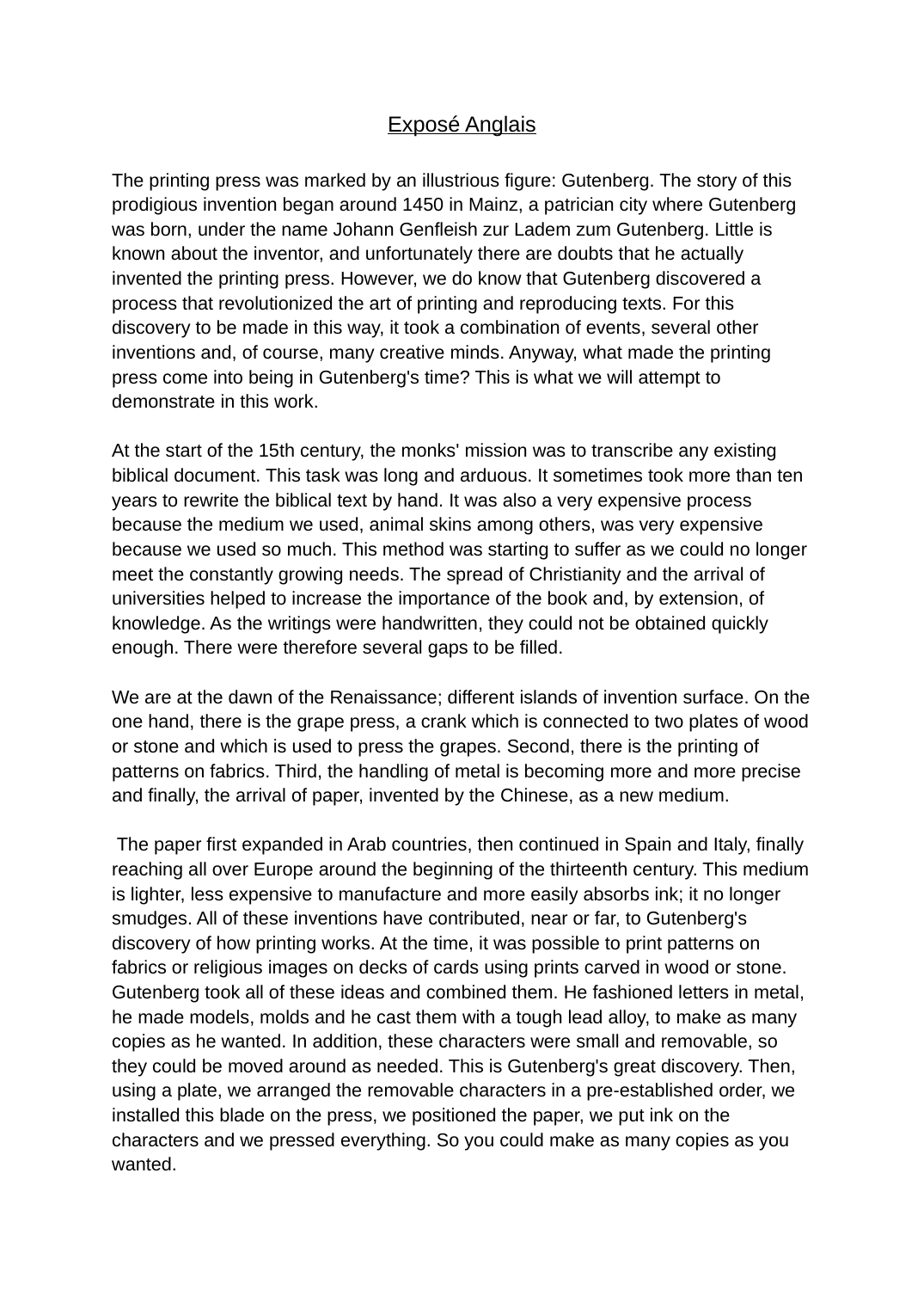Exposé Anglais The printing press
Publié le 07/01/2021

Extrait du document
«
Exposé Anglais
The printing press was marked by an illustrious figure: Gutenberg.
The story of this
prodigious invention began around 1450 in Mainz, a patrician city where Gutenberg
was born, under the name Johann Genfleish zur Ladem zum Gutenberg.
Little is
known about the inventor, and unfortunately there are doubts that he actually
invented the printing press.
However, we do know that Gutenberg discovered a
process that revolutionized the art of printing and reproducing texts.
For this
discovery to be made in this way, it took a combination of events, several other
inventions and, of course, many creative minds.
Anyway, what made the printing
press come into being in Gutenberg's time? This is what we will attempt to
demonstrate in this work.
At the start of the 15th century, the monks' mission was to transcribe any existing
biblical document.
This task was long and arduous.
It sometimes took more than ten
years to rewrite the biblical text by hand.
It was also a very expensive process
because the medium we used, animal skins among others, was very expensive
because we used so much.
This method was starting to suffer as we could no longer
meet the constantly growing needs.
The spread of Christianity and the arrival of
universities helped to increase the importance of the book and, by extension, of
knowledge.
As the writings were handwritten, they could not be obtained quickly
enough.
There were therefore several gaps to be filled.
We are at the dawn of the Renaissance; different islands of invention surface.
On the
one hand, there is the grape press, a crank which is connected to two plates of wood
or stone and which is used to press the grapes.
Second, there is the printing of
patterns on fabrics.
Third, the handling of metal is becoming more and more precise
and finally, the arrival of paper, invented by the Chinese, as a new medium.
The paper first expanded in Arab countries, then continued in Spain and Italy, finally
reaching all over Europe around the beginning of the thirteenth century.
This medium
is lighter, less expensive to manufacture and more easily absorbs ink; it no longer
smudges.
All of these inventions have contributed, near or far, to Gutenberg's
discovery of how printing works.
At the time, it was possible to print patterns on
fabrics or religious images on decks of cards using prints carved in wood or stone.
Gutenberg took all of these ideas and combined them.
He fashioned letters in metal,
he made models, molds and he cast them with a tough lead alloy, to make as many
copies as he wanted.
In addition, these characters were small and removable, so
they could be moved around as needed.
This is Gutenberg's great discovery.
Then,
using a plate, we arranged the removable characters in a pre-established order, we
installed this blade on the press, we positioned the paper, we put ink on the
characters and we pressed everything.
So you could make as many copies as you
wanted..
»
↓↓↓ APERÇU DU DOCUMENT ↓↓↓
Liens utiles
- exposé sur les violences animalières (ANGLAIS)
- essay anglais: In my opinion, the improvement of human capacities poses several problems
- Anglais leçons: Description Poster The Day After Tomorrow
- Anglais exposé: Lincoln
- LE DISCOURS D’UN ROIFrançais Anglais In the first instance, i’m going to recapitulate the movie for those of you who don’t know.


